How to Start an Interest Group
Written by Samuel Fuller
One thing that every applicant should seek out for their residency application is leadership opportunities. Every program wants to see that you have leadership skills. While it may initially be difficult to find leadership opportunities in medical school, you can find many interest groups that generally change leadership every year.
You can also join your specialty club interest group. This is a great way to get involved and show leadership in a field you might go into.
If you are passionate about something, like a specific specialty or a hobby, and there isn’t a club or interest group, you can start one.
The Idea
First, find something you are passionate about and want to run an interest group for. Next, check to see if your school has an organization for that interest. Most schools have a list of groups that already exist. If your school already has an organization you are interested in, great! Try to get involved and obtain a leadership position.
If there isn't an interest group that fits your passions, you can try to start an interest group. When thinking of an interest to start a group for, it is important to remember that other people need to be interested in the topic as well to have meetings. The best way to find people that might be interested is to ask friends, a faculty member to help organize activities for the group, and other classmates. Often your closest friends share many interests you do!
Logistics
Each school has different policies to create a new group. Some steps may include drafting a constitution, finding other leaders to help run the interest group, finding a clinical/professional mentor, or getting approval from a student/dean board. You may also need to meet with someone from the school to explain your idea and why there should be a new interest group. You should check your schools’ website through a simple search or ask your Student Affair's office for specific steps at your institution.
One of the most difficult of these steps is finding a clinical/professional mentor. The best way to find a mentor is to search within your university hospital and community to find physicians and other professionals who have done work in this related field. As long as the interest group isn’t super niche, there are likely faculty at your institution that might be interested in helping with the group. If you are fortunate enough to find more than one possible good fit, it is likely best to go for the person who is more responsive as you may have questions as you begin your new interest group.
Events
Once your club is established, it is important that other people know about it so they can join. A good way to do this is through a booth at an interest group fair for your school, which is generally held in the fall. You can also start a monthly email with updates or social media pages to include photos of events.
Creating monthly or quarterly follow-up meetings and events is a way to increase participation and interest in the group. For example, if the interest group is in a clinical field, an activity might be shadowing residents or other faculty. With Zoom, you can also set up a lecture series and invite faculty or residents from different institutions to participate.
Get inspired and good luck taking initiative!

